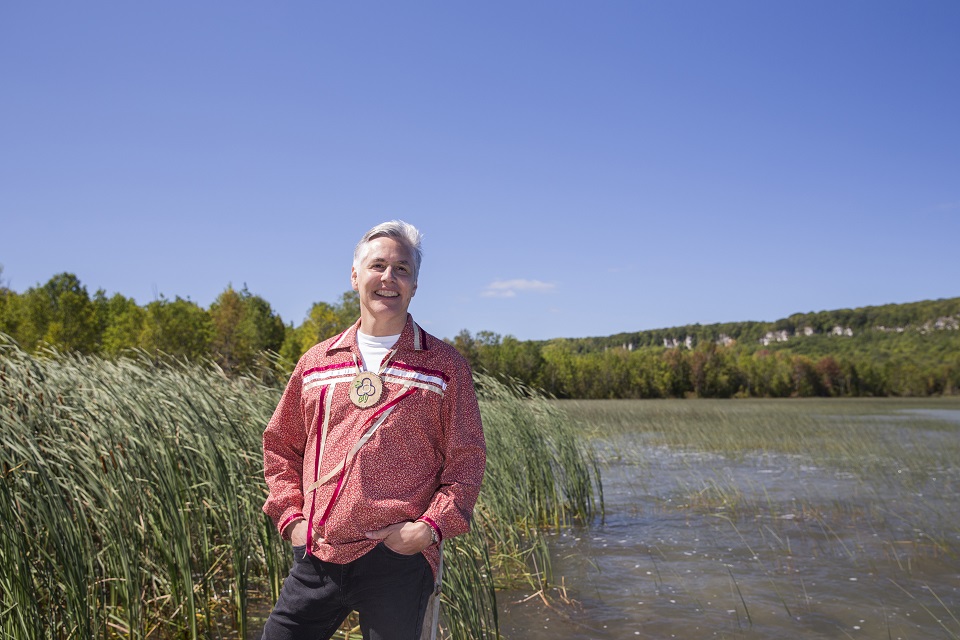Borrows received the highly distinguished award for his contributions to Indigenous rights and legal traditions

John Borrows, a UVic professor and the Canada Research Chair of Indigenous Law, has been appointed as an Officer of the Order of Canada. Borrows is well known for his trailblazing work in the field of Indigenous law and co-founded the Indigenous law degree program at UVic alongside colleague Val Napoleon. He is Anishinaabe/Ojibway and a member of the Chippewas of the Nawash First Nation in Ontario.
The Order of Canada is one of the highest honours that a civilian can receive.
Currently, Borrows is assisting in the creation of UVic’s National Centre for Indigenous Laws, which will be the first and only Indigenous Law Centre in Canada. The Indigenous law program is in its third year, with the first cohort involved in their first field school. He is also working on his latest book, Along Life’s Thin Edge.
Borrows has made significant contributions to the field of Indigenous law and fostered a broader awareness of Indigenous legal understandings over the course of his career. But, he admits, “there’s still a long way to go.”
When Borrows was finishing his last year of law school, a pivotal case in the interpretation of Indigenous rights was coming before the Supreme Court of Canada. R. v. Sparrow was the first major case to invoke section 35 of the 1982 constitution. Section 35 “recognized and affirmed” the existence of Aboriginal and treaty rights.
Since then, countless other cases have used section 35 to gain recognition for Indigenous law within Canada’s legal structures. Concurrently, Borrows says there has been a “consciousness raising” around Indigenous legal understandings and their importance.
“There has been a revitalization or a renaissance in relationship to Indigenous peoples’ political and legal decision making,” he said. Many Indigenous communities are having conversations about how to revitalize their traditions without replicating oppressive aspects. There is not a uniform definition of Indigenous law, and Borrows is seeing each community work through their own disagreements.
Despite the notable progress, the recognition of Indigenous law within the Canadian legal framework continues to face barriers. Although there have been important advancements through the courts, the accepted definition of self-government remains narrow, Borrows explains. Legislation that relates to Indigenous peoples is also far behind. Borrows says legislation is still being guided by the 1876 Indian Act, which iswas assimilatory by design.
“In the courts, the issue is to create decisions that would widen out where Indigenous peoples can make decisions in accordance with their aspirations,” he said. “In the legislatures, that point is to create legislation that would empower Indigenous peoples to make their own decisions [such as B.C.’s Declaration on the Rights of Indigenous Peoples Act].”
Borrows has played an active role in advancing these changes. But like many students, Borrows did not aim to become a law professor or an appointee to the Order of Canada. He actually wasn’t sure what to study and heeded the advice of his great grandpa: “get all the education you can, you can always carry it with you and no one can steal it from you.”
Although Borrows attributes part of his draw to a legal education as an “accident,” he also saw themes of justice and injustice in the community his family is from. Borrows’ great-great grandpa signed a treaty and his great grandpa was an Indian Act chief or councillor for 50 years.
Borrows saw there was a “need to see justice because of all of the neglect and failure [of the government] to abide by our own treaties.”
His forthcoming book, Along Life’s Thin Edge, reflects on some of these family relations as well. The book is a collection of letters to family from three to five years ago alongside his commentary on Indigenous law in relation to death.
At UVic, he is involved in a series of conversations with communities, lawyers, academics, and judges that will guide the future plans for the National Centre for Indigenous Laws. The centre will be a home for the JD/JID program and feature public lecture theatres, offices, a meeting space, Elders’ room and other spaces for ceremonies and sharing knowledge. The construction of the centre itself is expected to finish in 2023 and will extend the Murray and Anne Fraser building towards Ring Road.
The Indigenous law degree program was founded in 2018 and welcomed its third cohort of students this year. Formally known as the Joint Degree Program in Canadian Common Law and Indigenous Legal Orders (JD/JID), the four-year program involves two years of transsystemic learning in the classroom and two field schools in the final two years. The first cohort of students is now completing their first field school.
Having conversations about Indigenous rights and law with students has been a highlight of his career.
“All I’m trying to do is create pathways for people to get involved and understand Indigenous law and law’s relationship to the Canadian state,” he said.
“It’s just inspiring to me when students do come with all their different questions … that is what I love about my job and my life.”








